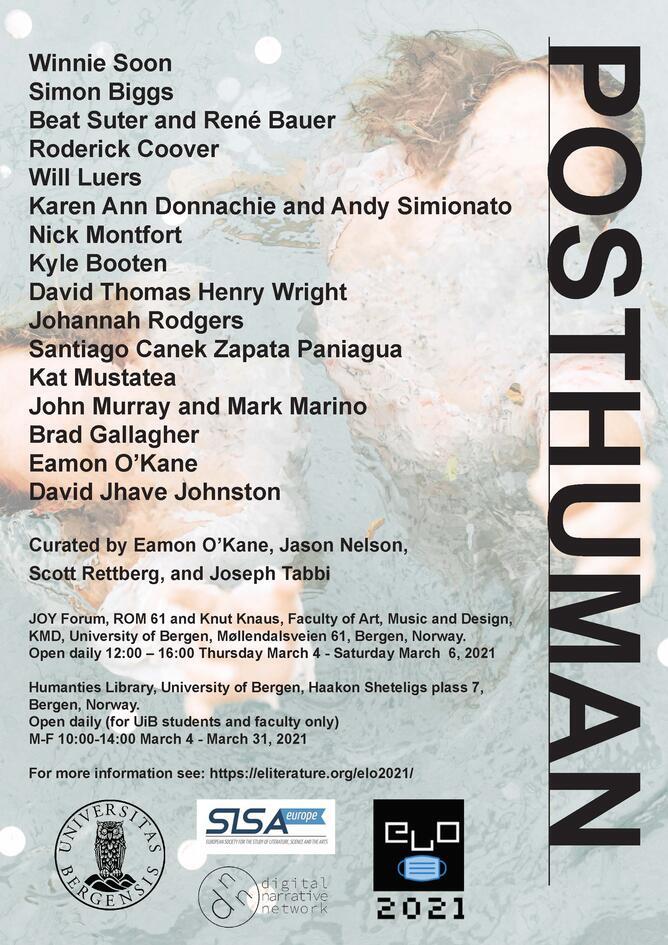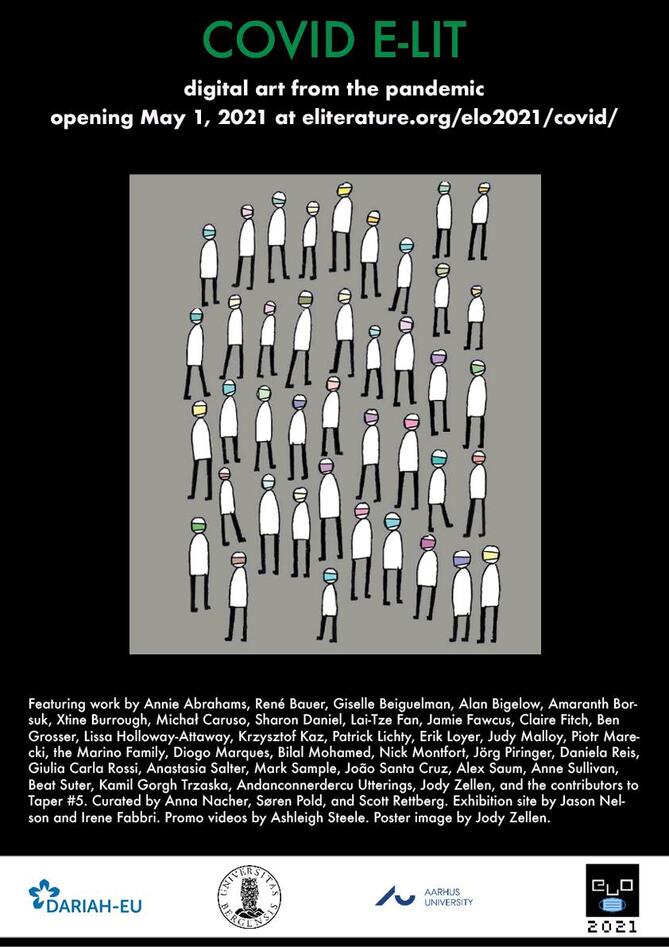Art, Academics, and Beyond at the Electronic Literature Organization Conference and Festival: Platform (Post?) Pandemic
ELO 2021 launches next week with a variety of virtual talks, workshops, and arts performances from May 24th - May 28th, as well as several permanent online exhibitions.

Hovedinnhold
This year's Electronic Literature Organization Conference and Festival is co-hosted by the University of Bergen, Norway, and Aarhus University, Denmark, with an eye to reflecting upon, critiquing, (mis)using, and recreating the virtual platforms that have become our lifelines during the COVID-19 pandemic. Above all, we ask: What kinds of futures can we imagine -- cultural, sociopolitical, artistic, intimate; in short, human -- on online platforms that are increasingly proprietary and opaque to most of their users? How has the global pandemic accelerated these platforms' importance in our interpersonal and professional lives, our social and political organizing, and our means for self-conception and -expression? What creative, critical possibilities for finding one's voice -- and others' voices -- do online platforms' border- and genre-breaking infrastructures afford?
Registration for the workshops, poster sessions, panels, keynote talks, and performances closes Sunday, May 23rd at 9AM (GMT+1). Register here. The arts exhibitions require no registration.
This five-day, fully virtual festival features:
Workshops where you can explore the unique affordances of web-based literature firsthand -- among them net improvisations; multimodal, interactive media interfaces; recombinatory narratives approaching the infinite; and digitally-mediated touch, spatiality, and movement.
Poster sessions introducing attendees to one of digital literature's analog ancestors (Pereira); queer (Fisher and Engel) and digitally sustainable (Schlesinger et al.) informatics; the gamification of professional life (Shepherd D., Shepherd B., and McEnery), and more.
Panels spanning the preservation and dissemination of tablet-based electronic literature (Boyd); pandemic manifestos (Hanna); born-digital writing's media-specific modes of authorship, readership, and circulation (Ackermans); electronic literature's efficacy in pedagogical contexts (Hedman); and interactive stories told through proprietary platforms such as Tinder (Rouse and Winter) -- among many others.
Keynote talks from Lai-Tze Fan (University of Waterloo, Canada -- "Unseen Hands: On the Gendered Design of Virtual Assistants and the Limits of Creative AI"), Archana Prasad (Dara.network and BeFantastic -- "RadBots: AI Augmented Writing towards Radical Video Bots"), and Olga Goriunova (Royal Holloway University, London, UK -- "Subject-making and aesthetics of data practices").
Live, participatory, and recorded performances by a range of artists, including blindfolded sound collective Utterings; keynote performances by Carrie Sijia Wang and Abraham Avnisan, Judd Morrissey, and Mark Jeffery; and a playthrough of PATTER(n)INGS: Apt. 3B (Holloway-Attaway and Fawcus, submitted to the COVID-19 arts exhibition).
Seven permanent art exhibitions with contributions from nearly one hundred different artists, divided into sub-themes (Posthuman; COVID-19; Platforms), sub-genres (Kids' E-Lit; Performances), and specific platforms (Flash/Shockwave; dra.ft).
Here's just a taste of what you'll find in the three sub-themed exhibitions:
Posthuman features works that engage with the posthuman condition -- complex assemblages of man and machine; their co-evolution and the new kinds of subjectivities this gives rise to; and futures in which aspects of our finitude, such as aging, mortality, and one's linear relationship to time, are overcome by technology. Explore the interconnections between Auden, Ashbery, and Stevens using a cutting-edge machine learning-based poetry generator (Gallagher, Gnarly Posthuman Conversations); create an uncanny new language using a text of your choice and a little help from artificial intelligence (Donnachie and Simionato, A.I. seems to be a verb); and enjoy a machine intelligence's attempts to process, narrate, and mimic sentient being in a work of recombitant cinema (Luers, Distant Affinities).
Among them, Winnie Soon’s Unerasable Characters II grapples with the phenomenology of algorithmic, authoritarian censorship in real-time. The piece pulls text from the timelines of popular, frequently censored users on popular Chinese microblogging site Weibo and displays each post, character-by-character, only for the amount of time they would remain visible on the site prior to deletion. The posts’ grid-like array resembles a night sky, studded with stars one moment only for these to flash into non-existence inside of a wide, black void the next -- a visual that powerfully reinforces the work's theme for its viewers regardless of their linguistic background. This piece was given a physical installation at the University of Bergen’s KMD Joy Forum, accessible to staff, faculty, and students.
(Quite literally) meanwhile, Kyle Booten’s web application To Pray Without Ceasing combs Twitter for expressions of need; generates prayers intended to be responsive to these needs from ones the artist himself has written; and asks the site’s visitors to light prayer candles on the application’s behalf. These candles grow smaller and go out as time passes. Visitors are asked to return to the site as they go about their day, taking care not to move their cursors too quickly as they top up candles’ flames, light new ones, and help this application with the work of prayer that’s been delegated to it by its visitors as much as by its artist. The piece simultaneously encourages and questions the value of such attention and mindfulness: Uncanny disjunctions in tone and content sometimes obtain between the automatic prayers and Twitter users’ needs, but only an autonomous application like this one could pray with such superhuman constancy and focus.
COVID-19 highlights works created during, about, and because of the pandemic. They explore how COVID-19 increased our already outsize (and largely unseen because ubiquitous) dependence on the platforms we use everyday (Grosser, The Endless Doomscroller; Saum, Room #3); how governments’ poor handling of the outbreak exacerbated existing sociopolitical issues, such as systemic racism’s effects on marginalized, at-risk Black lives in the United States (Daniel and Loyer, EXPOSED; Marino Family, Coronation: A Webcomic); and how it impacted our psyches, transforming our encounters with the day-to-day in its psychological as much as in its physical particulars (Borsuk, Curt Curtal Sonnet Corona; Burrough, I Got Up 2020: Pandemic Edition).
One piece that showcases how works of electronic literature can also be engaged, meaningful acts of activism and witnesses to injustice serving the broader public is Sharon Daniel and Erik Loyer’s EXPOSED. This site documents the spread of COVID-19 inside American prisons, jails, and detention centers from the perspectives of prisoners, detainees, and their families. The artists have assembled quotes, audio clips, and statistics collected from a comprehensive array of online publications and broadcasts into an interactive timeline that, on each day, offers abundant testimony to the risk, trauma, and extreme isolation that such prisoners have experienced during the COVID-19 pandemic -- inclusive of forcing persons suspected of infection into solitary confinement. They also trace the relationships between practices of quarantine, the American prison system, and policies of white supremacy, providing visitors with abundant resources for imagining -- and achieving -- a future free of an incarceration that dehumanizes the most vulnerable members of our communities.
A particularly personal work is Amaranth Borsuk’s Curt Curtal Sonnet Corona, which takes as its point of departure a program published at the start of the pandemic by Nick Montfort that can generate a crown of 3^14 or 4,782,969 potential sonnets. Its 14 monometer lines evoke the enclosure and uncertainty of initial lockdowns. Curt Curtal Sonnet Corona utilizes Montfort’s code to generate 4^11 or 4,194,304 curtal, 11-line sonnets with 4 variables per line. Each poem generated by this new code has a staccato, chant-like quality, as if pushing the reader forwards by the sheer force of its verbs; and the poem’s liminal, abstracted vignettes of daily life almost always culminate on a note of hopeful anticipation. In Borsuk’s words: “The abbreviated form felt appropriate to my feelings about this moment at the end of a very difficult year, but one illuminated by hope, as my son, due in January 2021, decided he couldn’t wait and joined our family in the final weeks of December.”
Finally, Platforming Utopias (and Platformed Dystopias) deals most explicitly with this year’s conference and festival theme. Selected works inquire after the real-world effects of globalized platforms such as mainstream social media sites (Twitter, Facebook, TikTok; Bonilla and Mata, Big Data; Bouchardon et al., A Web Odyssey); the ways in which once-physical sociocultural activities have changed as a result of the pandemic’s pushing them online -- something that has made them simultaneously more accessible to a broader public and more beholden to the standards of the proprietary services they depend upon for such access (ELO among them; J. Nelson, The Trajectory Cabinet; Malakasioti, Ode to a Fallen Dialogue); and the unique pieces -- artistic, academic, and activist -- born and sustained on the platforms we create (or adapt) for our own (E. Nelson, Directional Pilgrim; Cox, A Platform to Come: Translating Bergsonism - Deleuze [TBD]; Odom, Still I Rise: Remix).
For example, Mez Breeze’s "V[R]erses:" An XR Story Series inscribes microstories from a variety of authors onto 3D models created by the artist. Wander the surfaces of the statues/stories via direct manipulation of the XR platform’s 3D space; or let the stories’ numerically sequenced sections guide you up, down, and around the statues -- the XR platform enacts the texts’ language of movement. This series is particularly welcome after having spent most of the past year grappling with some combination of quarantine, lockdown, and social distancing, bringing often overlooked (and now sorely missed) objects of cultural and artistic cultural contemplation, such as statues, back into view -- and in a way that defies the limitations of our physical relationships with them.
We’re also excited to feature a new platform for disseminating and engaging with electronic literature called LAOB: The Language Art Observer, spearheaded by John Cayley, Daniel Howe, Allison Parrish, Rita Raley, Qianxun Chen, and Samantha Gorman. Inspired by magazines like Triple Canopy, the site will feature peer-reviewed pieces combining language arts and computation in some form, provided these pieces are first published as Observable ‘notebooks.’ Notebooks hosted on Observable permit artists to give their audiences greater insight into the process of creation and maintenance behind their pieces, making it possible not just to enjoy the finished product, but to explore the artist’s annotations, commentary, and code. It’s even possible -- and encouraged! -- for readers to ‘fork’ a piece’s notebook and to use this as a jumping off point for their own riffs on, remixes of, and workbooks about the original.
All of us on the ELO 2021 team hope you enjoy the festival and return to it in the years to come -- ones that we hope truly are post(?)-pandemic.


